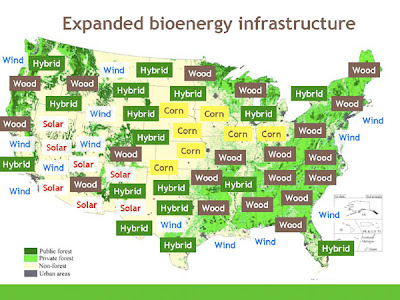#4 Bioenergy Can... Revive Depressed Economies
Bioenergy can revive depressed economies - local, national, and worldwide. Depressed economies need private investment in healthy industries to build lasting employment.
Depressed economies need private investment in healthy industries to build lasting employment.
Fossil energy - with all its societal costs and impact on the environment - is no longer viewed as "cheap." It is seen as an addiction - a wedge that is coming between our communities and their environment. In contrast, a burgeoning bioenergy industry is a way to revive communities by providing businesses that cannot be outsourced while creating purposeful work that brings people together with their natural resources. Here is a regional snapshot of the renewable energy patchwork that is currently developing thoroughout the continental U.S. The revitalization of the Corn Belt illustrates what could happen in other regions if we choose to expand our bioenergy infrastructure - for example, cellulose-based renewable energy from forests and hybrid crops in the Southeast and marginal lands of the country…
Here is a regional snapshot of the renewable energy patchwork that is currently developing thoroughout the continental U.S. The revitalization of the Corn Belt illustrates what could happen in other regions if we choose to expand our bioenergy infrastructure - for example, cellulose-based renewable energy from forests and hybrid crops in the Southeast and marginal lands of the country…
We could develop hundreds of biorefineries, produce billions of gallon of liquid fuel, generate thousands of megawatts of electricity, save billions of dollars in imports, create tens of thousands of jobs, and raise land values enough to revitalize communities. These are developments that are based on the economy of local supply and logistical support - generally we think in terms of a 75 mile biomass supply radius for each plant. Instead of the existing overly centralized energy paradigm, we would be developing regionally based energy solutions which greatly enhances security.
These are developments that are based on the economy of local supply and logistical support - generally we think in terms of a 75 mile biomass supply radius for each plant. Instead of the existing overly centralized energy paradigm, we would be developing regionally based energy solutions which greatly enhances security.
The forest products industry is already the biggest provider of renewable energy in the country - bigger than hydroelectric - supplying roughly 44% of current bioenergy. This change was initiated during the last major oil crisis in the 70’s but the boilers are not as efficient and clean as they could be. After thirty years they are due for replacement. The capital outlays for upgrading these facilities may mean the closure and outsourcing of much of our forest products industry to other countries.
A year and a half ago the American Forest and Paper Association published a study as part of its forward thinking 2020 Agenda Initiative. It was titled the Forest Products Industry Technology Roadmap. It outlines what alternative technologies are available and develops a scenario for how its members could insert new biochemical and thermochemical conversion technologies into their existing infrastructure to generate new and cleaner profit streams.
The TAPPI conference in Atlanta last May focused industry attention on these new ways to convert wood to biofuels and high value bioproducts like bioplastics and furfural, while cogenerating electricity and centralized heat to power their operations and local communities.
The challenge of reviving dying industries and communities is a major reason that people with tremendous financial resources (like venture capitalists Vinod Khosla, Bill Gates, and others leaders from previous paradigm shifts) are motivated to accept the risks of bioenergy investments. Part of the challenge is making sure that consistent governmental policies will make these investments economically sustainable over the long haul.  -------------
-------------
This article is the fourth in a series of five about the unique capabilities of bioenergy.
On November 28th I made a presentation at the Capitol Hill Club to the Biomass Coordinating Council (BCC) of the American Council on Renewable Energy (ACORE) titled "BioEnergy Can Do." My aim was to list what I considered to be the top five unique capabilities of bioenergy that should drive legislative action on Capitol Hill. The five capabilities are:
1. Bioenergy can convert solar energy into liquid fuel.
2. Bioenergy can reduce greenhouse gas emissions.
3. Bioenergy can remediate ecological disasters.
4. Bioenergy can revive depressed economies.
5. Bioenergy can expand energy freedom of choice.
-------------
technorati BIOconversion, bioenergy, biofuels, legislation, decentralization, security



No comments:
Post a Comment